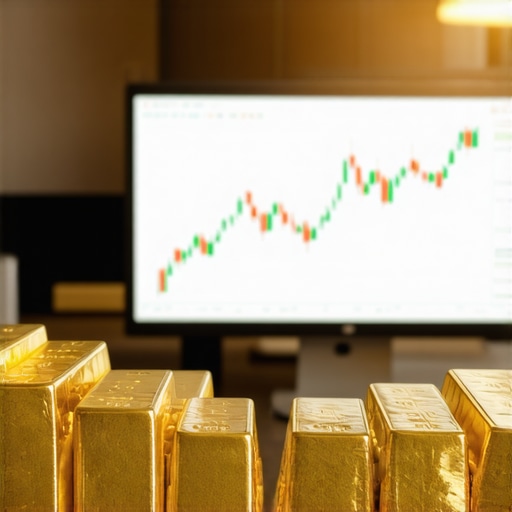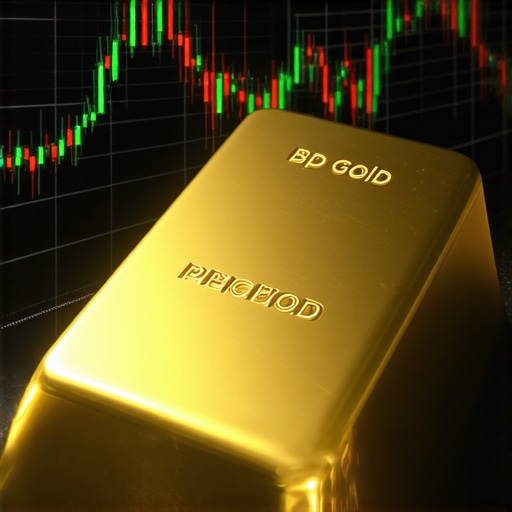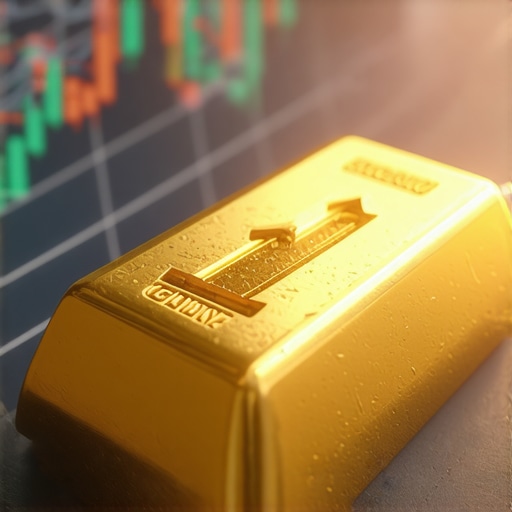Understanding Gold Price Dynamics in 2025
As the global economy fluctuates, investors are increasingly turning to gold as a safeguard against market volatility and inflation. Forecasting gold prices involves analyzing various factors, including economic indicators, geopolitical events, and market demand, which can heavily influence price trends. In 2025, understanding these dynamics will be crucial for anyone looking to invest in this precious metal effectively.
Key Factors Influencing Gold Prices
The gold market is influenced by a myriad of factors that can lead to price fluctuations. One of the primary elements is global economic stability. When economies are strong, demand for gold typically decreases as investors gravitate towards equities and other assets. Conversely, during economic downturns or recessions, gold often sees a surge in demand as it is viewed as a safe haven.
Another significant factor is geopolitical events. Tensions between countries, trade wars, and conflicts can lead to increased demand for gold, as investors seek to protect their assets. For instance, a recent spike in geopolitical conflicts has historically led to a rise in gold prices, as the market reacts to uncertainty.
The Role of Supply and Demand
Supply and demand play a crucial role in forecasting gold prices. The supply of gold is relatively inelastic, meaning that it does not respond quickly to price changes. This inelasticity can lead to significant price movements when demand fluctuates. For example, if demand increases significantly due to economic uncertainty, prices can rise sharply since the supply cannot be adjusted quickly.
Moreover, central bank policies can also impact gold prices. Many central banks hold gold as part of their reserves, and their buying or selling activities can influence market prices. In recent years, nations have been increasing their gold reserves as a hedge against economic instability, which further affects supply-demand dynamics.
Predictions for Gold Prices in 2025
Analysts predict that gold prices may continue to rise in 2025, influenced by ongoing economic uncertainties and changes in monetary policy. The 2025 gold price forecast suggests that as inflation concerns persist and interest rates fluctuate, gold will likely remain a preferred asset for investors looking for stability in their portfolios.
In addition, advancements in technology and changes in mining practices could also play a role in shaping the future of gold prices. As mining becomes more efficient, we may see changes in supply that could influence prices in the market.
Strategies for Investing in Gold
For investors looking to capitalize on these trends, it’s essential to develop a solid investment strategy. This includes diversifying investments across various gold assets, such as gold ETFs, physical gold, and gold mining stocks. Each of these options offers different benefits and risks that investors should consider carefully.
Furthermore, monitoring price trends and market analysis will be vital. Keeping abreast of gold market trends, such as those discussed in gold market analysis, can provide investors with insights necessary for making informed decisions.
Strategies for Investing in Gold
For investors looking to capitalize on the fluctuating gold market, developing a robust investment strategy is essential. This strategy should encompass a variety of gold assets, including gold ETFs, physical gold, gold stocks, and even gold mutual funds. Each of these investment vehicles offers unique benefits and risks that should be assessed to align with individual investment goals.
Diversification Within Gold Investments
Diversifying your gold investments is crucial to mitigate risks while maximizing potential returns. By investing in a mix of gold mutual funds and gold stocks, investors can gain exposure to different aspects of the gold market. For instance, while gold stocks can offer high returns during market upswings, mutual funds can provide a more stable investment option by spreading risk across multiple assets.
Monitoring Market Trends
Staying informed about market trends is vital for successful gold investments. Investors should regularly review gold market analysis reports and updates to understand how global economic conditions might affect prices. By tracking key indicators such as central bank policies, inflation rates, and geopolitical tensions, investors can make informed decisions about when to buy or sell.
Utilizing Technical Analysis
In addition to fundamental analysis, many investors find value in employing technical analysis to forecast gold price movements. This method involves studying historical price charts to identify patterns and trends that can indicate future price behavior. Investors can enhance their trading strategies by utilizing tools like moving averages and resistance levels to make educated decisions.
Long-Term vs. Short-Term Investment Strategies
When it comes to investing in gold, it’s important to define whether you’re aiming for short-term gains or long-term stability. Short-term traders might capitalize on market volatility by buying and selling gold quickly based on price movements. In contrast, long-term investors may focus on accumulating gold as a hedge against inflation or economic downturns, viewing it as a stable asset that can preserve wealth over time.
Understanding Gold Demand Trends
Another critical aspect of forecasting gold prices is understanding demand trends. As highlighted in gold demand trends, various factors such as jewelry consumption, industrial use, and investment demand play significant roles in shaping price movements. For instance, increasing demand for gold in emerging markets can lead to price surges, making it essential for investors to monitor these trends closely.
Global Economic Indicators
Finally, global economic indicators such as GDP growth rates, employment statistics, and inflation levels can have a profound impact on gold prices. Investors should keep an eye on these indicators and consider how they influence investor sentiment toward gold as a safe haven asset. In times of economic uncertainty, gold typically experiences increased demand, which can drive prices higher.
As we delve deeper into the intricacies of investing in gold, understanding these strategies and market dynamics will empower investors to make informed choices that align with their financial objectives.
Long-Term vs. Short-Term Gold Investment Strategies
When considering how to invest in gold, defining your investment horizon is critical. Long-term investors might accumulate gold gradually, viewing it as a hedge against inflation or economic instability. They typically rely on the long-term price trends and buy during dips to maximize their holdings over time.
On the other hand, short-term traders focus on market volatility, buying and selling gold based on price movements. This strategy requires a keen understanding of technical analysis and market signals, enabling investors to capitalize on quick gains.
Understanding Gold Demand Trends
Another essential aspect of gold investment involves understanding demand trends. Factors such as jewelry consumption, industrial usage, and investment demand significantly impact gold prices. For example, rising demand in developing economies can lead to higher prices, making it essential for investors to stay informed about these trends.
Market Indicators to Watch
Investors should also monitor key market indicators that can influence gold prices. Economic indicators such as GDP growth, inflation rates, and employment statistics provide insights into the health of the economy. In times of economic uncertainty or recession, gold often sees increased demand as investors flock to its perceived security. Tracking these indicators helps investors anticipate market movements and adjust their strategies accordingly.
Technical Analysis for Gold Investments
Utilizing technical analysis can be a game-changer for investors looking to understand price movements. This method involves analyzing historical price charts, identifying patterns, and using tools such as moving averages and support levels to predict future behaviors. By applying technical analysis, investors can make more informed decisions about their gold investments, enhancing their chances of success.
Building a Balanced Gold Portfolio
Creating a diversified gold portfolio is essential to mitigate risk while maximizing returns. Investors can consider a mix of gold mutual funds, gold ETFs, and gold mining stocks to achieve this balance. Each investment type offers unique benefits and risk profiles, allowing investors to tailor their portfolios according to their financial goals.
For instance, while investing in gold mining stocks can yield high returns during favorable market conditions, gold ETFs provide a more liquid and easily tradable option. By diversifying across these asset classes, investors can better navigate market fluctuations.
Staying Updated on Gold Market Analysis
Regularly reviewing gold market analysis reports is vital for investors. These reports offer insights into how global economic conditions and geopolitical events impact gold prices. Keeping abreast of market trends and forecasts can empower investors to make timely decisions, whether it’s buying during a dip or selling to take profits.
Assessing Gold Investment Performance
Evaluating the performance of your gold investments is crucial for long-term success. This includes reviewing how individual assets perform relative to market conditions and adjusting your strategy accordingly. Regular assessments can help identify underperforming assets and inform future investment decisions.
By combining a solid understanding of market dynamics, technical analysis, and performance evaluation, investors can build a robust strategy for navigating the complex gold market in 2025. As we explore further, we will delve into the impact of geopolitical factors on gold prices and how they influence investment strategies.
Understanding the Impact of Geopolitical Events on Gold Prices
Geopolitical events play a crucial role in shaping the gold market, often triggering fluctuations in prices. Investors must stay vigilant about international developments, as these events can lead to increased demand for gold, viewed as a safe haven during times of uncertainty. For instance, rising tensions in global hotspots frequently correlate with spikes in gold prices, reflecting heightened investor anxiety.
Recent Geopolitical Trends Affecting Gold
In recent years, we have witnessed a surge in geopolitical tensions, be it trade wars, conflicts, or diplomatic disputes. These situations create an environment where investors seek stability, prompting many to turn to gold. For example, ongoing conflicts in various regions have historically led to a flight towards gold, causing prices to rise as demand surges. Investors should monitor such developments closely, as they can impact their strategies significantly.
Inflation and Currency Fluctuations
Geopolitical events can also influence inflation rates and currency values, further impacting gold prices. When uncertainty looms, central banks may adjust their monetary policies in response, which can lead to inflationary pressures. As inflation rises, the attractiveness of gold as a hedge against currency devaluation increases, driving demand. Investors should keep an eye on global inflation trends and how they relate to geopolitical events, as this can inform their investment decisions.
Market Sentiment and Gold Investment Strategies
Understanding market sentiment is vital for successful gold investments. During times of geopolitical tension, investor sentiment often leans towards caution, resulting in increased buying of gold. This shift creates opportunities for investors to position themselves effectively. Monitoring sentiment indicators and staying informed about related news can help investors make timely decisions regarding their gold investments.
To capitalize on these trends, investors should consider developing a comprehensive strategy that incorporates geopolitical analysis alongside traditional market factors. This approach ensures that they account for the potential impacts of global events on their portfolios. An effective strategy may also involve diversifying across different gold investment vehicles, such as gold ETFs, physical gold, and gold stocks.
Long-Term Perspectives on Gold Investment
Taking a long-term perspective is key when navigating the complexities of the gold market. While short-term fluctuations can be influenced by immediate geopolitical events, understanding the broader context is essential. Investors should analyze historical trends in gold prices relative to major geopolitical events, gaining insights into how such occurrences have shaped market behavior over time. This historical perspective can guide future investment decisions.
Conclusion: Navigating the Gold Market Amidst Geopolitical Challenges
In conclusion, understanding the impact of geopolitical events on gold prices is crucial for investors looking to navigate the market effectively. By staying informed about global developments and their potential implications on economic stability, inflation, and market sentiment, investors can build robust strategies that optimize their gold investments. For further insights into gold market analysis and trends, be sure to explore our comprehensive guides designed to empower your investment journey.
Frequently Asked Questions About Gold Investments
1. What factors influence gold prices in 2025?
Gold prices in 2025 will be influenced by various factors, including global economic stability, geopolitical events, inflation rates, and central bank policies. As investors seek stability, these elements can lead to increased demand for gold, impacting its price.
2. How can I invest in gold effectively?
Effective gold investment strategies include diversifying your portfolio with various gold assets such as physical gold, gold ETFs, and gold mining stocks. Monitoring market trends and utilizing technical analysis can also help you make informed decisions.
3. Is investing in gold a good hedge against inflation?
Yes, gold is often considered a hedge against inflation. When inflation rises, the purchasing power of currency decreases, making gold an attractive option for preserving wealth. Investors typically increase their gold holdings during inflationary periods.
4. What are the risks associated with gold investments?
Gold investments carry risks such as market volatility, price fluctuations, and geopolitical uncertainties. It’s crucial to stay informed about market trends and global events that can impact gold prices, allowing you to mitigate these risks effectively.
5. How does geopolitical tension affect gold prices?
Geopolitical tension often leads to increased demand for gold as investors seek safe-haven assets during uncertain times. Historical trends show that conflicts and diplomatic disputes can correlate with spikes in gold prices, reflecting investor anxiety.
6. What are the benefits of gold ETFs compared to physical gold?
Gold ETFs offer liquidity, ease of trading, and lower storage costs compared to physical gold. They provide exposure to gold prices without the need for physical handling, making them an attractive option for many investors.
7. How do I monitor gold market trends?
Monitoring gold market trends can be done through regular reviews of market analysis reports, following economic indicators, and staying updated on geopolitical news. Utilizing resources that focus on gold price forecasts and trends can enhance your investment strategy.
8. Should I invest in gold for short-term or long-term?
Your investment strategy should align with your financial goals. Short-term traders may capitalize on price movements, while long-term investors typically accumulate gold as a hedge against inflation and economic instability.
9. Can I invest in gold mining stocks?
Yes, investing in gold mining stocks can provide exposure to the gold market. These stocks can yield high returns during favorable market conditions, but they also carry risks associated with operational challenges and market fluctuations.
10. Where can I find reliable information about gold investments?
Reliable information can be found through trusted financial news websites, investment analysis platforms, and expert publications on gold market trends. Resources such as the World Gold Council and financial market analysts can provide valuable insights into gold investments.
Authority Resources for Gold Investments
For investors seeking reliable information and insights into gold investments, the following resources are highly recommended:
- World Gold Council – A leading authority on gold market trends and insights.
- Kitco Metals – Provides live market data, analysis, and news related to precious metals.
- Investing.com – Offers comprehensive financial news and analysis, including gold market trends.
- Bloomberg Markets – A trusted source for financial data and investment insights.
- MarketWatch – Provides market news, analysis, and insights on gold investing.
- Forbes – Features articles and news related to gold investments and market trends.
Conclusion: Navigating the Gold Market in 2025
As we look toward 2025, understanding the dynamics of gold investment is essential for making informed decisions. By considering factors such as geopolitical events, economic indicators, and effective investment strategies, you can navigate the gold market with confidence. Whether you’re a long-term investor or a short-term trader, staying updated on market trends and utilizing reliable resources will empower you to optimize your gold investments. Embrace the opportunities that gold presents and position yourself for success in the evolving investment landscape.










What struck me most about the article is the delicate balance between economic stability and geopolitical tensions in driving gold prices. Having followed the market for years, I’ve noticed how quickly sentiment can shift with just a single geopolitical event, often leading to sudden spikes in gold demand. This unpredictability makes it crucial to stay informed in real-time. I also appreciate the emphasis on diversifying gold investments—not just holding physical gold but also exploring ETFs and mining stocks, which can help manage risk. In my experience, combining fundamental analysis with technical charting provides a more comprehensive picture, especially when timing short-term trades. However, one challenge I face is determining the right allocation between short-term trading and long-term holding, especially when inflation signals are mixed. How do other investors navigate the tension between seizing short-term opportunities and preserving gold’s role as a long-term hedge? It would be great to hear strategies that balance these approaches while considering the unpredictable nature of supply in the gold market.